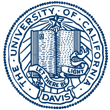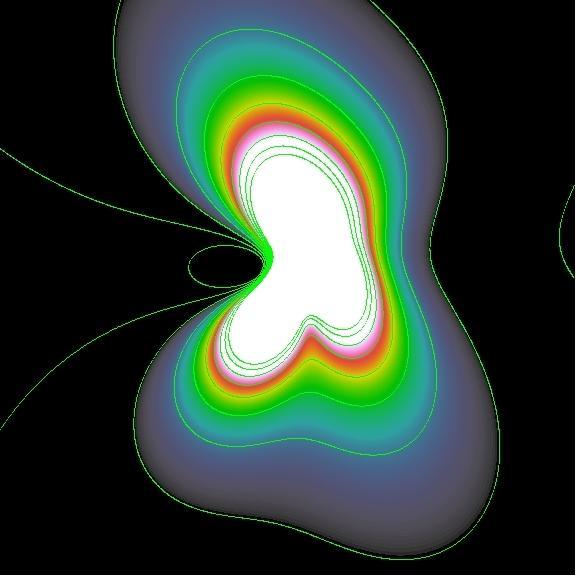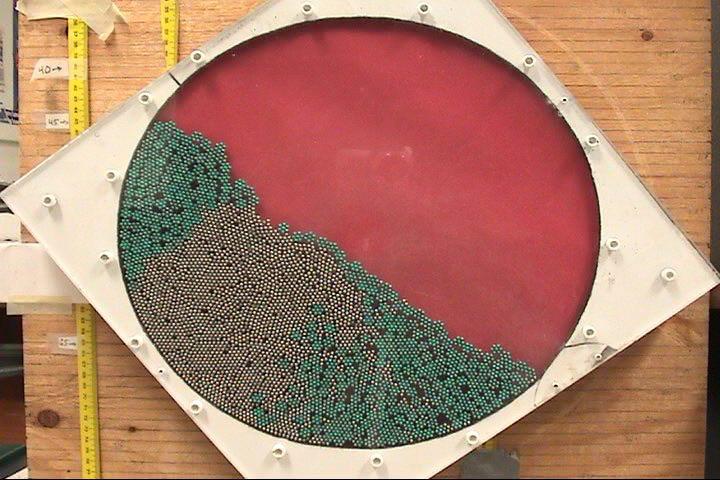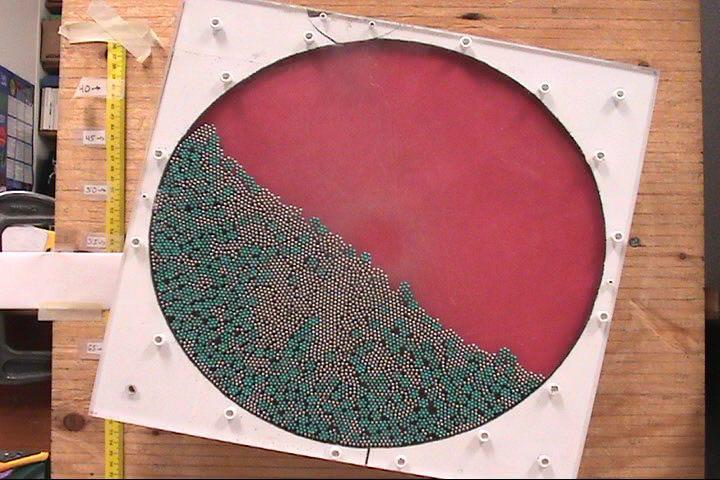
This REU program was funded through NSF PHY-1004848.


These images are at spatial extremes: silver atoms on the surface of germanium, and the mass distribution of a galaxy.
Students' names link to their final papers. Advisors' names link to the research group web pages.
Condensed Matter Experiment
The behavior of materials at interfaces is particularly important in fabricating new types of microscopic devices. Emilie Huffman (Union College; advisor Shirley Chiang) used both Scanning Tunneling Microscopy (STM) and Low Energy Electron Microscopy (LEEM) to image silver and iridium atoms on the surface of germanium. STM is a static measurement that achieves atomic or near-atomic resolution. LEEM has lower resolution but acquires images fast enough to make ``movies" of the surface behavior. The two techniques can complement each other by providing both detailed structural and dynamical information. Emilie's results were quite complex. For example, silver atoms can form three separate structures on the surface of germanium (this is the left image at the top of the page), and when the density of silver is about enough to half-cover the surface, all three phases exist simultaneously. Iridium on germanium also forms two lattice structures, one hexagonal and the other square. Finally LEEM measurements show how silver on a different surface of germanium grows in long islands which change shape with temperature. These observations can be followed up with studies to understand the growth conditions needed for particular phases and how the surface phases affect properties from conductivity to reactivity.
Over the past few decades, computer speeds have steadily increased as the size of processors has decreased. Packing the circuitry into ever smaller spaces reduces the distance that electrons travel as they carry information through the system. Yet the ability to shrink transistors may eventually end; already their sizes are approaching a regime where quantum mechanical effects may alter their behavior. Furthermore, arranging to carry away the heat generated by such closely packed electronics is another challenge. One possibility for improving future computer performance is to make a major change to computers based on photons rather than electrons, so that information within the computer will travel at the speed of light. Drew Peterson (American River College; advisor Dong Yu ) studied a promising photonic material, PbSe. Certain excitations in PbSe have a large length scale, so that corresponding quantum effects appear in samples tens of nanometers across. This should result in non-linear optical properties, a key to developing photonics. Drew fabricated tiny "quantum dots" of PbSe, organized them into thin films, and measured their optical behavior at infra-red frequencies. He has transfered to UC Davis and will continue to study how film thickness and purity affects the optical properties.
For many decades, all known superconductors followed certain patterns, such as not being magnetic. In recent years researchers have found several families of superconductors that violate the empirical "rules," most notably the high-temperature oxide superconductors discovered in the late 1980's. In addition to magnetic behavior, common unusual properties include electrons that act much heavier than isolated electrons, a new mechanism for forming the pairs of electrons required for superconductivity, and highly anisotropic properties of the quantum mechanical wave function that describes the superconducting state. Better understanding how universal these features are and how they relate to one another may help in achieving room-temperature superconductors. Melissa Trepanier (Rochester Institute of Technology; advisor Rena Zieve) studied CaFe2As2 under uniaxial pressure. This material has a superconducting transition at low temperatures that seems related to a structural and magnetic phase transition at much higher temperature. Melissa measured the effect of pressure on the structural/magnetic transition. The next step is to examine how pressure affects the superconductivity, and to relate the two sets of measurements to each other.
Miguel Fernandez Flores (Truman State University; advisor Rena Zieve) analyzed avalanches in a two-dimensional granular pile. He acquired photos of hundreds of avalanches in an "articifial sandpile" with two types of grain shapes, hexagons and dimers. Some configurations of the pile are more stable than others; the angle of the pile's free surface just before an avalanche can vary by about 15 degrees. Miguel used various software to identify the locations within the pile of each type of shape, to sort the avalanches by angle, and to search for patterns in the grain configurations that tended to produce particularly high or low avalanche angles. He could not identify any strong links between the configuration and the avalanche angle. This was quite surprising because Miguel also showed that the same range of avalanche angles occurs for configurations that at first glance appear wildly different. In the images below, the hexagons are colored green. Configurations like that on the left, where the hexagons are in two clumps near the sides of the pile, have identical avalanche behavior to ones like the right-hand image, where the hexagons generally lie near the outer edge of the container but the segregation is much less severe. Presumably some local instability gives rise to each avalanche, but how piles with such different arrangements all have the same instability remains unclear.

Biological Physics
Kevin Chen (The College of New Jersey; advisor Xiangdong Zhu) worked on improving the sensitivity of Oblique Incidence Reflectivity Difference (OI-RD), a new technique for monitoring biological reactions that Professor Zhu's lab has been developing for several years. Since the method is is currently less sensitive than traditional radioactive labelling techniques, Kevin tested a method of amplifying the signals. The addition of a protein that binds to the antibodies under study did increase the size of the observed signal. One benefit of the protein binding technique is that reagents will not need to be highly purified; as long as the protein binds to only one of the antibodies present, the behavior of that antibody will dominate the signal. The technique could be especially useful for studies of expensive antibodies, since with the enhanced signals smaller concentrations could be used.
Knowing a protein's three-dimensional structure is crucial to understanding its behavior. Depending on how it folds, certain portions may be available to interact witih other molecules or may be blocked or even hidden. The vast majority of known protein structures have been determined through x-ray crystallography, but that technique only works when a protein crystallizes well and can be obtained in large quantities. Marilyn Werner (St. Olaf's College; advisor Daniel Cox) worked on an alternative technique of identifying protein structure from infrared absorption. Marilyn focused on carbonyls (carbon-oxygen double bonds) and how nearby carbonyls affect each others' absorption frequencies. She wrote a program to calculate spectra for different structures; ultimately comparing the calculations for possible protein structures with experimental results on the same protein could identify which structure is correct. The next step, though, is to test the software by comparing its results with experiment for proteins whose structure is already known.
Complex Systems
Andrew Smith (Butler College; advisor Jim Crutchfield ) studied different ways to encode equivalent information about a dynamical system. Using four simple one-dimensional maps as examples, Andrew looked at partitions of the spatial region by considering where different starting points would end up after many iterations of a map. The patterns he generated varied substantially among the maps. Such patterns could prove useful in developing maps with desired properties, such as experimental probes that would be sensitive in a specific regime. For now the goal is to understand what the partitions say about the original map: how do different aspects of the partitions relate to properties of the equations governing time development?
General Relativity
Causal Dynamical Triangulation (CDT) is an approach to quantizing the theory of gravity. David Kamensky (University of Virginia; advisor Steve Carlip) programmed an ongoing implementation of CDT. The idea is to divide ("triangulate") spacetime into fundamental shapes and then study the spacetime as it undergoes a random walk among possible triangulations. David worked on implementing this for two spatial and one time dimension, where the fundamental shapes are tetrahedra. In particular, the spatial part of his spacetime was the surface of a three-dimensional sphere and he considered periodic distortions where the spacetime ultimately returned to its initial configuration. He wound up with apparently functional code; the next step is to generate physically meaningful initial conditions to use with it.
Elementary Particle Experiment
The Large Underground Xenon (LUX) detector is designed to observe weakly interacting massive particles (WIMPs), one of the possible forms of dark matter. The WIMPs can interact with a gigantic vat of liquid xenon, and the resulting photons and electrons will register in detectors surrounding the vat. Addi Fyhrie (University of California, Berkeley; advisors Bob Svoboda and Mani Tripathi) wrote code in C++ to extract key parameters from events detected in photomultiplier tubes, testing her software with events from a small-scale trial version of LUX. She also compared her results with similar software written in Matlab at another university. The two generally agree, and the few discrepancies seem likely to be issues in the Matlab code.
One concern with LUX is that neutrons can interact with the xenon in a way simil ar to WIMPs, creating a background signal. Knowing the exact magnitude of the background is crucial for the experiment. This means measuring the exact concentration of radioactive impurities in the materials used in LUX. In particular, much of the apparatus is constructed from titanium, which is known to have small amounts of potassium, thorium, and uranium impurities. Since the exact amount of impurities various from one batch of titanium to another, Charles Dresser (California State University, Sacramento; advisors Bob Svoboda and Mani Tripathi) worked on a new, fast method of measuring the impurity levels. Rather than simply waiting for long times and monitoring a very small decay rate (the half-life of 238U is about 5 billion years!), the idea is to excite the radioactive elements into other atoms that have shorter half-lives. Charles successfully measured several isotope concentrations, including potassium, using this technique. He is continuing work during the schoolyear to solve a remaining issue with detection of uranium and thorium.
Astrophysics
Megan Geen (Wheaton College; advisors Marusa Bradac and Chris Fassnacht) looked at a galaxy cluster formed recently (on an astronomical timescale!) when two clusters collided with each other. She found examples of strong gravitational lensing, where the bending of light around very dense objects creates multiple images of a single source. She then used the patterns of multiple images to find the mass distribution of the dark matter in the cluster. Calculating the lensing effects from a given set of objects and lenses is straightforward, but the reverse problem of identifying the positions and masses from a lensed image is not. It requires making some educated guesses and checking them, which Megan did. The dark matter distribution she found tracked the galaxies, rather than the interstellar gas, showing that during the collision the dark matter behaved similarly to the regular matter in the galaxies.
For hundreds or perhaps thousands of years, humans have wondered how special we are. We now know that the earth is not the center of the universe, nor is the sun, nor even our galaxy. Recently astronomers have found that planets orbiting stars are quite common, although difficult to detect. Apart from the philosophical implications for our place in the universe and the possibility of finding extraterrestrial life, the discovery of additional planetary systems can help scientists understand how such arrangements form and develop. Nick Kullman (University of Missouri; advisor Matt Richter ) worked on identifying planets through the motion of their stars: as the planet orbits a star, the star undergoes a corresponding but much smaller motion. The heavier the star is relative to the planet, the less the star moves. Nick examined data on about 40 small M Dwarf stars, which should be quite sensitive to orbiting planets. He used a variety of software to account for the slight variations in gain and efficiency among the individual pixels in the CCD, a calculation which has to be redone for each measured wavelength. Then he searched for periodicities in the stars' velocities. Most did not exhibit periodic behavior, and the few that did had such long periods that the time span of the measurements was insufficient; longer observations are needed to identify the periods conclusively. Nick's analysis shows which stars are worth further observation.